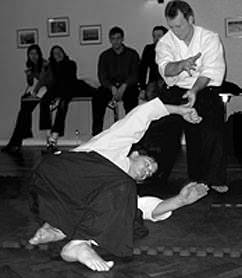Ukemi - receiving a technique
 "
"
One of the most controversial aspects of the martial arts. How should the recipient of a technique react? Taken too far one way, uke reels from every strike and flicks into the air at the first sign of a throw. Too far the other way and tori is left with the choice of either doing it for real — breaking joints and noses, or walking away shrugging.
There's obviously no one correct answer. With someone first learning a technique, uke may need to perform their side of the technique despite what tori is doing: manipulating their partner into performing the technique despite themselves. Alternatively, uke may need to resist a technique; perhaps to demonstrate an inadequacy in the technique, or perhaps to discover for themselves whether or not the technique is effective.
Away from these two extremes, my preference is for an active uke: probing the boundaries of the technique for weaknesses but acknowledging the actions of tori. If uke is sufficiently responsive it is possible for tori to perform techniques with commitment and integrity whilst uke survives to return another day.
Tori and uke form a partnership, both seeking to perform a martial art. There is a need for a communication between the two in order to agree the manner in which to perform. So how do you achieve that communication?
In my view, there's no substitute for mat time. But not just passively performing techniques. If you find that you're being thrown easily, question it. Try staying on your feet, moving beyond tori or just plain resisting. Does the technique still work? Don't believe in "… and now I would break your wrist" techniques. Challenge them. It will hurt, but at the end of it you will know what works and what doesn't. Alternatively, are you the uke that no one can throw? Are you failing to be honest with your partner? Are you ignoring his two fingers hooked into your eye sockets? Or attacking with a punch that never covers more than half the distance between you?
Find a partner you trust. You are going to hurt each other, you need to both feel confident in the other. Work through some of the basic techniques with full commitment from both sides. Find out what works and what doesn't. Once you've experienced and understood a committed technique, bring that feeling into your training when techniques are being performed at a lower intensity.
And above all: smile!